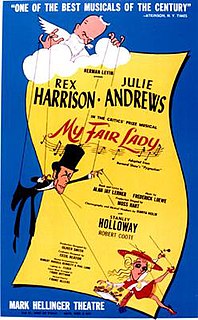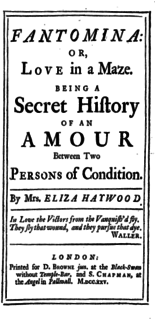
My Fair Lady is a musical based on George Bernard Shaw's Pygmalion, with book and lyrics by Alan Jay Lerner and music by Frederick Loewe. The story concerns Eliza Doolittle, a Cockney flower girl who takes speech lessons from professor Henry Higgins, a phoneticist, so that she may pass as a lady. The original Broadway and London shows starred Rex Harrison and Julie Andrews.
This article presents lists of the literary events and publications in 1696.

Emma Dorothy Eliza Nevitte Southworth was an American writer of more than 60 novels in the latter part of the 19th century. She was the most popular American novelist of her day.

Oroonoko: or, the Royal Slave is a short work of prose fiction by Aphra Behn (1640–1689), published in 1688 by William Canning and reissued with two other fictions later that year. The eponymous hero is an African prince from Coramantien who is tricked into slavery and sold to British colonists in Surinam where he meets the narrator. Behn's text is a first-person account of his life, love, rebellion, and execution.
Charles Gildon, was an English hack writer who was, by turns, a translator, biographer, essayist, playwright, poet, author of fictional letters, fabulist, short story author, and critic. He provided the source for many lives of Restoration figures, although he appears to have propagated or invented numerous errors with them. He is remembered best as a target of Alexander Pope's in both Dunciad and the Epistle to Dr. Arbuthnot and an enemy of Jonathan Swift's. Gildon's biographies are, in many cases, the only biographies available, but they have nearly without exception been shown to have wholesale invention in them. Because of Pope's caricature of Gildon, but also because of the sheer volume and rapidity of his writings, Gildon has come to stand as the epitome of the hired pen and the literary opportunist.

Love in Excess (1719–1720) is Eliza Haywood's best known novel. It details the amorous escapades of Count D'Elmont, a rake who becomes reformed over the course of the novel. Love in Excess was a huge bestseller in its time, going through multiple reissues in the four years following its initial publication. It was once compared in terms of book sales with Gulliver's Travels and Robinson Crusoe. This information was revealed to be incorrect, the believed success of this novel is much more marginal, selling only about 6000 copies over 23 years.

Restoration literature is the English literature written during the historical period commonly referred to as the English Restoration (1660–1689), which corresponds to the last years of the direct Stuart reign in England, Scotland, Wales, and Ireland. In general, the term is used to denote roughly homogeneous styles of literature that center on a celebration of or reaction to the restored court of Charles II. It is a literature that includes extremes, for it encompasses both Paradise Lost and the Earl of Rochester's Sodom, the high-spirited sexual comedy of The Country Wife and the moral wisdom of The Pilgrim's Progress. It saw Locke's Treatises of Government, the founding of the Royal Society, the experiments and holy meditations of Robert Boyle, the hysterical attacks on theaters from Jeremy Collier, and the pioneering of literary criticism from John Dryden and John Dennis. The period witnessed news become a commodity, the essay develop into a periodical art form, and the beginnings of textual criticism.
The Sofa: A Moral Tale is a 1742 libertine novel by Claude Prosper Jolyot de Crébillon. It was first translated into English in the spring of 1742 in an edition published by John Nourse and Thomas Cooper. This translation has been attributed to Eliza Haywood and William Hatchett.

Amatory fiction is a genre of British literature that became popular during the late 17th century and early 18th century, approximately 1660-1730. It was often spread throughout coteries, published while trying to remain true to the writer's vision without criticism. Amatory fiction predates, and in some ways predicts, the invention of the novel and is an early predecessor of the romance novel. Indeed, many themes of the contemporary romance novel were first explored in amatory fiction. The writing of amatory fiction work was dominated by women, and it was considered to have mainly female readers; but it is assumed that men read these novels as well As its name implies, amatory fiction is preoccupied with sexual love and romance. Most of its works were short stories.
Dale Spender is an Australian feminist scholar, teacher, writer and consultant.
Janet Margaret Todd OBE is a British academic and author. She was educated at Cambridge University and the University of Florida, where she undertook a doctorate on the poet John Clare. Much of her work concerns Mary Wollstonecraft, Jane Austen, and their circles.
A prosimetrum is a poetic composition which exploits a combination of prose (prosa) and verse (metrum); in particular, it is a text composed in alternating segments of prose and verse. It is widely found in Western and Eastern literature. While narrative prosimetrum may encompass at one extreme a prose story with occasional verse interspersed, and at the other, verse with occasional prose explanations, in true prosimetrum the two forms are represented in more equal measure. A distinction is sometimes drawn between texts in which verse is the dominant form and those in which prose dominates; there the terms prosimetrum and versiprose are applied respectively.

Elizabeth Singer Rowe was an English poet, essayist and fiction writer described as "the ornament of her sex and age" and the "Heavenly Singer". She was among the most widely read 18th-century English authors. She wrote mainly religious poetry, but her best known Friendship in Death (1728) consisted of a series of imaginary letters from the dead to the living. Despite a posthumous reputation as a pious, bereaved recluse, Rowe kept up a wide correspondence and was involved in local concerns at Frome in her native Somerset. She remained popular and often translated well into the 19th century, on both sides of the Atlantic. Though little read today, scholars note she was stylistically and thematically radical for her time.
The History of the Nun, or The Fair Vow Breaker, is a novella by Aphra Behn published in 1689. It is a piece of early 18th-century amatory fiction.

Love-Letters Between a Nobleman and His Sister is an anonymously published three-volume roman à clef playing with events of the Monmouth Rebellion and exploring the genre of the epistolary novel. It has been attributed to Aphra Behn, but this attribution remains in dispute. The novel is "based loosely on an affair between Ford, Lord Grey of Werke, and his wife's sister, Lady Henrietta Berkeley, a scandal that broke in London in 1682". It was originally published as three separate volumes: Love-Letters Between a Noble-Man and his Sister (1684), Love-Letters from a Noble Man to his Sister: Mixt with the History of Their Adventures. The Second Part by the Same Hand (1685), and The Amours of Philander and Silvia (1687). The copyright holder was Joseph Hindmarsh, later joined by Jacob Tonson.

A novel is a relatively long work of narrative fiction, normally written in prose form, and which is typically published as a book.
The Female Spectator, published by Eliza Haywood between 1744-1746, is generally considered to be the first periodical written by women for women.











